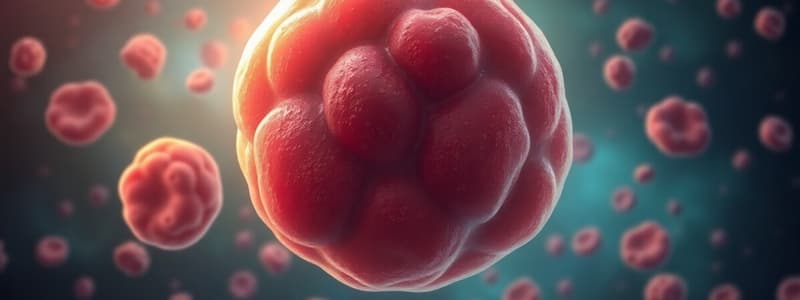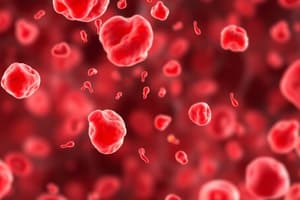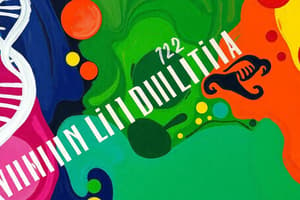Podcast
Questions and Answers
What is the underlying cause of the abnormally large, immature red blood cells seen in megaloblastic anemia?
What is the underlying cause of the abnormally large, immature red blood cells seen in megaloblastic anemia?
- Impaired DNA synthesis due to vitamin B12 and/or folate deficiencies. (correct)
- Accelerated red blood cell maturation in the bone marrow.
- Excessive production of intrinsic factor in the stomach.
- Increased iron absorption in the ileum.
Which of the following is NOT a common cause of megaloblastic dyspoiesis?
Which of the following is NOT a common cause of megaloblastic dyspoiesis?
- Certain medications like methotrexate
- Vitamin B12 deficiency
- Iron overload (correct)
- Folate deficiency
A patient is diagnosed with megaloblastic anemia. Which dietary change would be LEAST effective in directly addressing the cause of their anemia?
A patient is diagnosed with megaloblastic anemia. Which dietary change would be LEAST effective in directly addressing the cause of their anemia?
- Adding more leafy green vegetables to their diet.
- Increasing intake of refined grains and sugars. (correct)
- Increasing intake of meat and liver.
- Consuming more eggs and cheese.
Why is intrinsic factor essential for normal erythropoiesis?
Why is intrinsic factor essential for normal erythropoiesis?
A patient's blood work indicates a deficiency in intrinsic factor. Where is the most likely site of the underlying problem causing this deficiency?
A patient's blood work indicates a deficiency in intrinsic factor. Where is the most likely site of the underlying problem causing this deficiency?
What is the primary mechanism by which vitamin B12 is absorbed into the bloodstream?
What is the primary mechanism by which vitamin B12 is absorbed into the bloodstream?
Which protein is responsible for transporting vitamin B12 in the plasma?
Which protein is responsible for transporting vitamin B12 in the plasma?
Where is transcobalamin II primarily synthesized?
Where is transcobalamin II primarily synthesized?
A patient presents with neurological symptoms and macrocytic anemia. Further testing reveals a deficiency of intrinsic factor. Which of the following is the MOST likely cause of their condition?
A patient presents with neurological symptoms and macrocytic anemia. Further testing reveals a deficiency of intrinsic factor. Which of the following is the MOST likely cause of their condition?
If a patient has undergone a partial ileectomy, what vitamin deficiency are they most at risk of developing?
If a patient has undergone a partial ileectomy, what vitamin deficiency are they most at risk of developing?
Flashcards
Primary defect in megaloblastic anemia
Primary defect in megaloblastic anemia
Impaired DNA synthesis leading to large, immature red blood cells due to deficiencies in Vitamin B12 and Folate.
Causes of megaloblastic dyspoiesis
Causes of megaloblastic dyspoiesis
Vitamin B12 deficiency, Folate deficiency, and certain medications (e.g., methotrexate).
Sources of vitamin B12
Sources of vitamin B12
Meat, liver, eggs, cheese, fish, kidney, and clams.
Substance for B12 absorption
Substance for B12 absorption
Signup and view all the flashcards
Site of Intrinsic Factor production
Site of Intrinsic Factor production
Signup and view all the flashcards
Site of vitamin B12 absorption
Site of vitamin B12 absorption
Signup and view all the flashcards
Transport protein for vitamin B12
Transport protein for vitamin B12
Signup and view all the flashcards
Where is transcobalamin II produced?
Where is transcobalamin II produced?
Signup and view all the flashcards
Study Notes
- The primary defect in megaloblastic anemia is impaired DNA synthesis
- Impaired DNA synthesis leads to abnormally large, immature red blood cells
- Deficiencies in Vitamin B12 and Folate can cause impaired DNA synthesis and megaloblastic anemia
Causes of Megaloblastic Dyspoiesis
- Vitamin B12 deficiency
- Folate deficiency
- Certain medications, like methotrexate
Sources of Vitamin B12
- Meat
- Liver
- Eggs
- Cheese
- Fish
- Kidney
- Clams
Absorption of Vitamin B12
- Intrinsic factor is necessary for the absorption of vitamin B12
- Intrinsic Factor (IF) is produced by the parietal cells of the stomach
- Vitamin B12 is absorbed in the ileum (last part of the small intestine)
Transport of Vitamin B12
- Transcobalamin II is the transport protein for vitamin B12
- Transcobalamin II is produced primarily by the cells of the intestinal mucosa
Studying That Suits You
Use AI to generate personalized quizzes and flashcards to suit your learning preferences.



